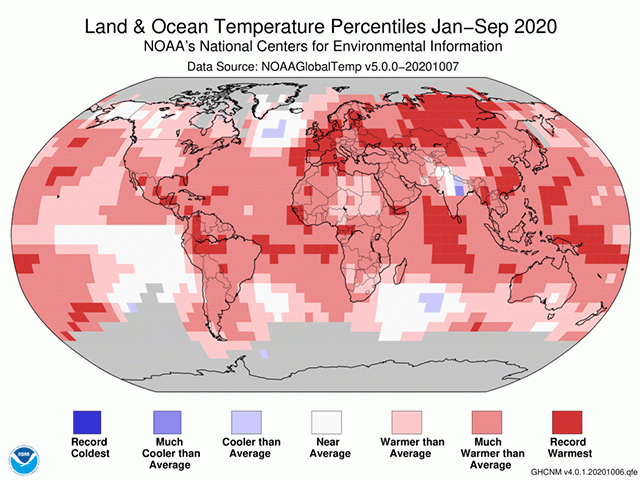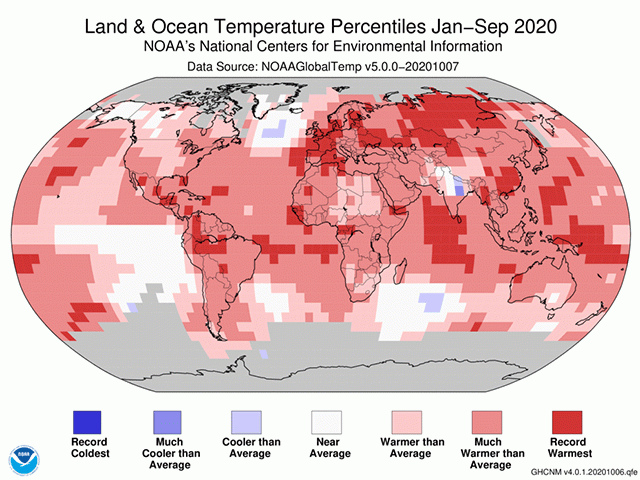Ag Weather Forum
Record-Warm Globe in September
Climate summaries for the world are out for September. Highlights from the report published by the National Centers for Environmental Information (NCEI) are noted in this space. In brief: record warm, with some departures from long-term averages that are astonishing. The 21st-century global warmth is roaring along.
The September 2020 globally averaged temperature departure from average over land and ocean surfaces was the highest for the month of September in the 141-year NOAA global temperature dataset record, which dates back to 1880.
The September 2020 global land and ocean surface temperature was the highest for September in the 141-year record at 1.7 degrees Fahrenheit (0.97 degrees Celsius) above the 20th-century average of 59.0 deg F (15.0 deg C). This value surpassed the now second-highest September temperature that took place in 2015 and 2016 by 0.04 deg F (0.02 deg C).
September 2020 marked the 44th consecutive September and the 429th consecutive month with temperatures, at least nominally, above the 20th-century average. The 10 warmest Septembers have all occurred since 2005. The seven warmest Septembers have occurred in the last seven years (2014-2020).
The Southern Hemisphere's land and ocean surface temperature departure from average for September 2020 was the highest on record at 1.26 deg F (0.70 deg C) above average, surpassing the previous record set in September 2015, 2017 and 2018 by 0.02 deg F (0.01 deg C). Meanwhile, the Northern Hemisphere had its third-warmest September on record with a combined land and ocean surface temperature departure from average of 2.18 deg F (1.21 deg C). *NOTE: Such a departure of more than 2 degrees Fahrenheit is a LEAP above average.*
Europe had its warmest September on record with a temperature departure from average of 4.19 deg F (2.33 deg C) above average. This exceeded the previous record set in 2018 by 0.40 deg F (0.22 deg C). South America, Asia and Oceania had their second-warmest September on record.
P[L1] D[0x0] M[300x250] OOP[F] ADUNIT[] T[]
Warmer-than-average temperatures were present across much of the globe during September 2020, with the most notable warm temperature departures from average across parts of the North Pacific Ocean, southwestern Canada, the western contiguous U.S., South America, Europe, northern and southeastern Asia, Australia and Antarctica, where temperatures were at least 2.7 deg F (1.5 deg C) above average. Cooler-than-average conditions were limited to parts of Greenland and surrounding Atlantic Ocean, eastern Canada, the eastern U.S., the tropical eastern and central Pacific Ocean, the southern Indian Ocean and the western part of Asia and northern Africa.
The September average Arctic sea ice extent was the second smallest for September on record at 961,000 square miles (38.8%) below the 1981-2010 average, according to an analysis by the National Snow and Ice Data Center (NSIDC) using data from NOAA and NASA. Only September 2012 had a smaller extent. On Sept. 15, the Arctic sea ice extent reached its minimum annual extent of 1.44 million square miles, which is the second-smallest minimum extent on record, behind Sept. 17, 2012. The 14 smallest minimum annual extents have occurred in the last 14 years.
Antarctic sea ice extent during September 2020 was above average at 7.25 million square miles. This was the 13th-largest September Antarctic sea ice extent in the 42-year satellite record. According to NSIDC, Antarctica may have reached its annual maximum extent on Sept. 28 when it reached 7.32 million square miles.
The year-to-date global land and ocean surface temperature was the second-highest in the 141-year record at 1.84 deg F (1.02 deg C) above the 20th-century average of 57.5 deg F (14.1 deg C). This value is only 0.07 deg F (0.04 deg C) shy of tying the record set in 2016.
The Northern Hemisphere January-September land and ocean surface temperature tied with 2016 as the warmest such period since global records began in 1880, while the Southern Hemisphere had its fourth warmest such period on record.
Europe, Asia and the Gulf of Mexico had their warmest January-September period on record. South America and the Caribbean region had a January-September temperature that ranked as the second-highest on record.
Warmer-than-average temperatures were present across much of the global land and ocean surfaces during January-September. The most notable warm temperature departures were observed across northern Asia, where temperatures were at least 5.4 deg F (3.0 deg C) above average. *NOTE: This is an ASTOUNDING jump above average.*
Meanwhile, cooler-than-average conditions were limited to Alaska, western Canada, northern India and across the southern oceans.
Record-warm January-September temperatures were present across much of northern Asia and across parts of southeastern China, Europe, northern Africa, northern South America, Central America as well as the Atlantic, Indian and Pacific oceans.
According to a statistical analysis done by NCEI scientists, the year 2020 is very likely to rank among the three warmest years on record.
The full report with additional graphics is at this link: https://www.ncdc.noaa.gov/….
Bryce Anderson can be reached at bryce.anderson@dtn.com
Follow him on Twitter @BAndersonDTN
(c) Copyright 2020 DTN, LLC. All rights reserved.






Comments
To comment, please Log In or Join our Community .